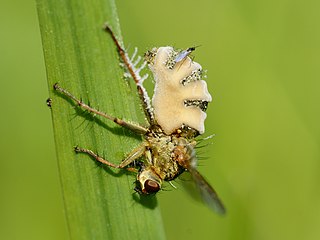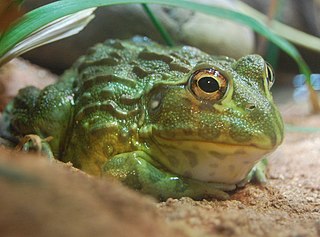
The bird family Petroicidae includes 49 species in 19 genera. All are endemic to Australasia: New Guinea, Australia, New Zealand and numerous Pacific Islands as far east as Samoa. For want of an accurate common name, the family is often called the Australasian robins. Within the family species are known variously as robins, scrub-robins and flyrobins. They are only distantly related to the European robin of Europe, north Africa and western Asia, a member of family Muscicapidae.

The family Cisticolidae is a group of about 160 warblers, small passerine birds found mainly in warmer southern regions of the Old World. They were formerly included within the Old World warbler family Sylviidae.

Gymnophthalmidae is a family of lizards with at least 250 species, sometimes known commonly as spectacled lizards or microteiids. They are called "spectacled" because of their transparent lower eyelids, which allow them to still see with closed eyes. As in most lizards, except geckos, these eyelids are movable. The Alopoglossidae have been recently moved from this family.
In biology, a monotypic taxon is a taxonomic group (taxon) that contains only one immediately subordinate taxon.

Mantidae is one of the largest families in the order of praying mantises, based on the type species Mantis religiosa; however, most genera are tropical or subtropical. Historically, this was the only family in the order, and many references still use the term "mantid" to refer to any mantis. Technically, however, "mantid" refers only to members of the family Mantidae, and not the 14 remaining families of mantises. Some of the most recent classifications have promoted a number of the mantid subfamilies to the rank of family, e.g. Iridopterygidae, Sibyllidae, Tarachodidae, Thespidae, and Toxoderidae, while other classifications have reduced the number of subfamilies without elevating to higher rank.

An entomopathogenic fungus is a fungus that can act as a parasite of insects and kills or seriously disables them.

The Entomophthorales are an order of fungi that were previously classified in the class Zygomycetes. A new subdivision, Entomophthoromycotina, has recently been circumscribed for them.

Nectogalini is a tribe of Old World water shrews within the family Soricidae. As of late 2007, it consisted of six extant genera and 25 species, with some of the latter being further divided into subspecies.

Scincinae is a subfamily of lizards. The subfamily contains 33 genera, and the genera contain a combined total of 284 species, commonly called skinks. The systematics is at times controversial. The group is probably paraphyletic. It is one of three subfamilies of the family Scincidae, the other two being Acontinae and Lygosominae.

Entomophthora muscae is a species of pathogenic fungus in the order Entomophthorales which causes a fatal disease in flies. It can cause epizootic outbreaks of disease in houseflies and has been investigated as a potential biological control agent.

The Pyxicephalidae are a family of frogs found in sub-Saharan Africa.

The Cultrinae are one of at least 13 subfamilies of cyprinid fish. It contains ten genera.

Entomophaga is a genus of entomopathogenic fungi in the order Entomophthorales. Well-known species are E. grylli and E. maimaiga, which infect grasshoppers and gypsy moths respectively.

Entomophthoromycota is a fungus division. In 2007, it was placed at the taxonomic rank of subphylum in the most recent revision of the entire fungus kingdom. In 2012, it was raised to the rank of phylum as "Entomophthoromycota" in a scientific paper by Richard A. Humber 2012. Divided into three classes and six families, it contains over 250 species that are mostly arthropod pathogens or soil- and litter-borne saprobes.
Pandora is a genus of fungi within the order Entomophthorales of the Zygomycota.
Entomophaga grylli is a fungal pathogen which infects and kills grasshoppers. It is the causal agent of one of the most widespread diseases affecting grasshoppers. This is sometimes known as summit disease because infected insects climb to the upper part of a plant and grip the tip of the stem as they die; this ensures widespread dispersal of the fungal spores. The fungus is a species complex with several different pathotypes, each one of which seems to be host-specific to different subfamilies of grasshoppers. The pathogen is being investigated for its possible use in biological pest control of grasshoppers.
Neozygites remaudierei is a microscopic fungus in the order Entomophthorales, which affects aphids, particularly Myzocallis coryli.
Neozygites slavi is a microscopic fungus in the order Entomophthorales, which affects aphids, particularly Slavum esfandiarii.

The Solanaceae, or nightshades, are a family of flowering plants that ranges from annual and perennial herbs to vines, lianas, epiphytes, shrubs, and trees, and includes a number of agricultural crops, medicinal plants, spices, weeds, and ornamentals. Many members of the family contain potent alkaloids, and some are highly toxic, but many—including tomatoes, potatoes, eggplant, bell and chili peppers—are used as food. The family belongs to the order Solanales, in the asterid group and class Magnoliopsida (dicotyledons). The Solanaceae consists of about 98 genera and some 2,700 species, with a great diversity of habitats, morphology and ecology.
Massospora is a genus of fungi within the order Entomophthorales of the Zygomycota. It includes more than a dozen obligate, sexually transmissible pathogenic species that infect adult gregarious cicadas (Hemiptera) worldwide. At least two species are known to produce psychoactive compounds during infection.












